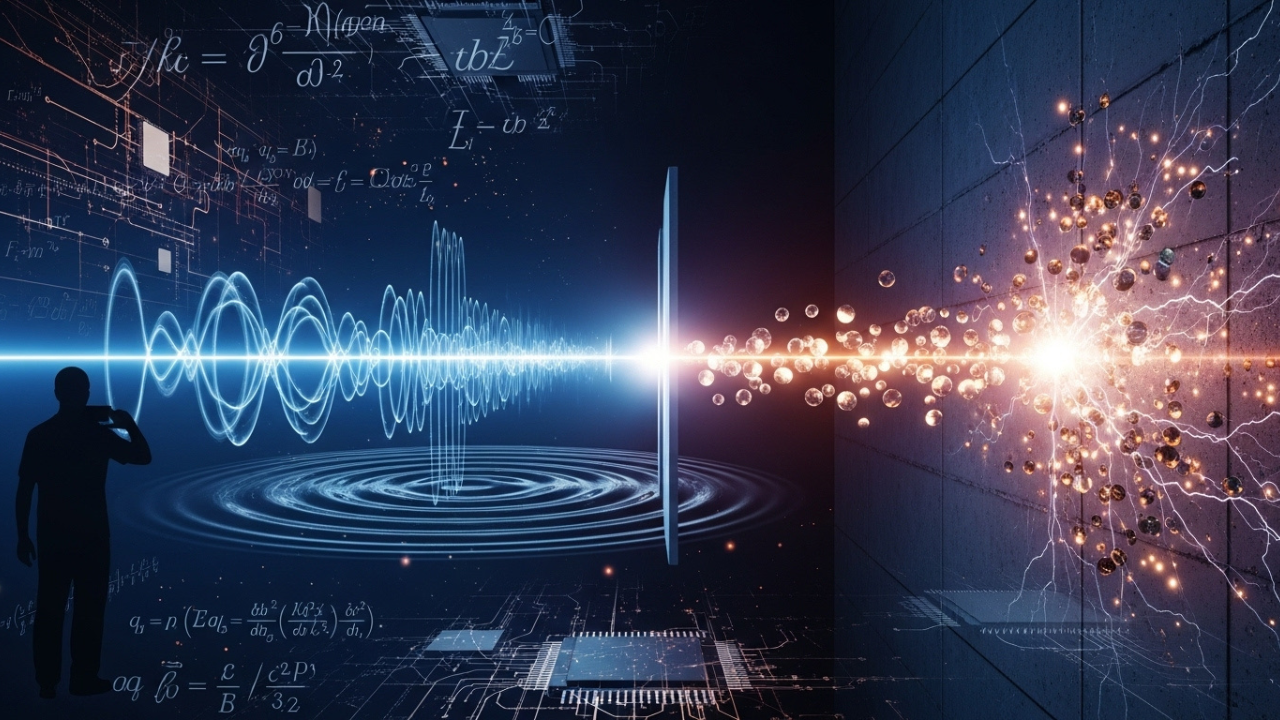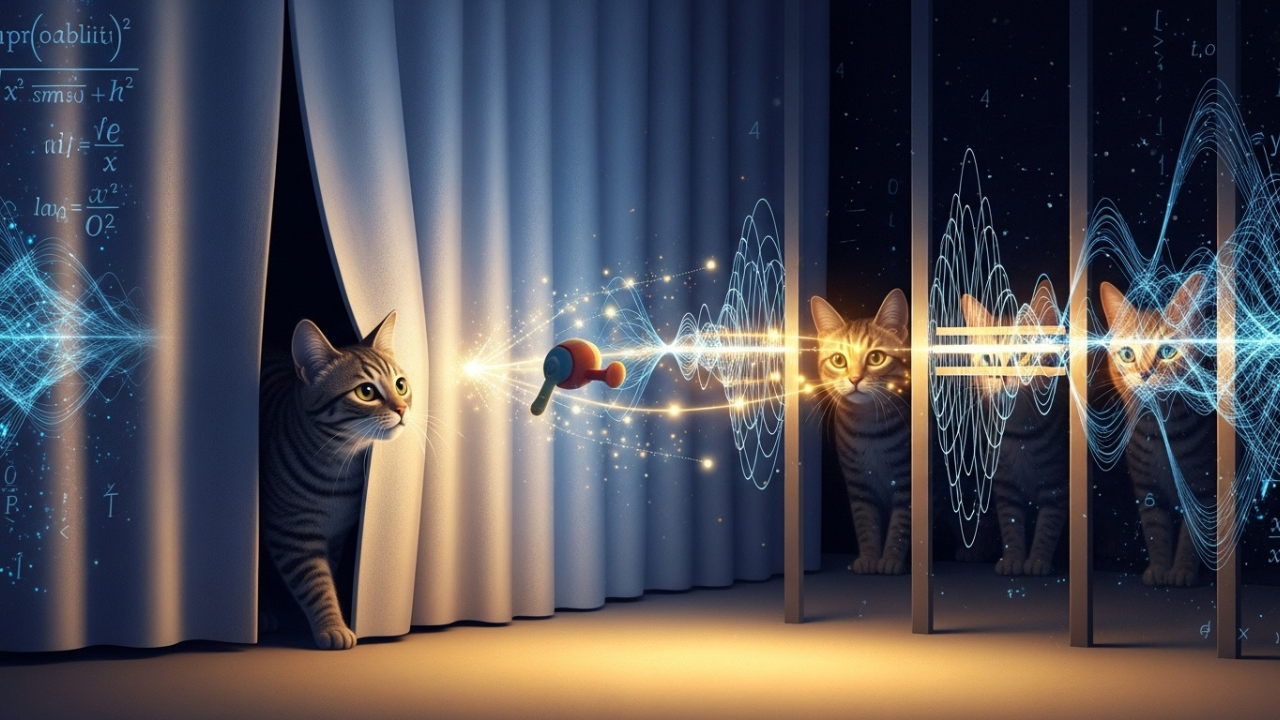When I was first told that light was more than just a wave, I assumed the individual was only making a joke.
From my understanding, I had seen rainbows, reflections, light ripples; in fact everything in the universe acted like waves in water per my textbook.
But then, suddenly, without any suggestion, came the notion that light could also function as if it were tiny particles akin to invisble marbles zooming through the universe. That’s quite a baffling thought for a student—it’s infuriating. And honestly, it’s quite a mind-boggling thought Why is it that something can exist in both states simultaneously?
Key Takeaways
- Wave-particle duality refers to quantum objects oscillating like waves and displaying particle-like behavior depending on how they are viewed.
- Light and electrons also demonstrate interference patterns even when sent one at a time which is proof of their wave nature.
- Observation indeed collapse the wave to a particle state thereby changing the outcome of the experiment.
- This concept forms the basis of modern technologies such as computer systems, lasers, macroscopes, and even quantum computers.
- Mindset mattered the least, so long as wondering was the primary goal while in due course of time knowledge was bound to follow.
What Science First Believed About Light
Looking back at the origins of the field of physics, we can note that it began with a single debate that has not been completely solved even in modern day. In contrast to Huygens, who believed that light was a wave, Newton was convinced that light consisted of discrete particles.
For a very long time, evidence came forth to support neither of the competing sides, instead relying on balanced folklore featuring two well-recognized figureheads. Then came experiments that supported the wave model almost exclusively. Light could bend. Light could spread out through slits. Light could also interfere with itself to create bands of brightness and darkness (and/or vice versa). That was possible for waves. Not so much for particles.
The well-known double-slit test confirmed new theories. A light beam passed through two narrow slits, and the resulting pattern on the screen behind resembled exactly the interference pattern created by two pebbles thrown into a lake—where ripples met, they amplified or canceled each other. That was only possible if light was a wave, which it is. That’s all there was to it until someone did the same experiment with single photons—single particles of light—and it shifted everything.
One Photon At A Time
This is where things begin to get a bit… odd. When using the double slit experiment, physicists thought that a single photon would act more like a bullet and go through either slit one at a time. To their surprise, when later repeated in the pattern of each single photon hitting the screen individually, an overall pattern started to form. That same interference pattern appeared as if every photon was somehow going through both slits and interfered with itself. Consider that for a second.
A singular particle doing the impossible, behaving like a wave, going two different directions at the same time, creating a pattern that is usually created by waves seaming by waves, and being layered on top of each other. It then became more than just light, it became about reality itself.
As if this were not strange enough, the proverbial cherry on top gained sight of the photon’s path to the screen and began placing detectors on its path. They were completely shocked at what they saw; the moment they added the ability to measure the path photons took through the slits, the previously supposed constant patterns changed “as if a curtain were lifted on chaos”. Instead of an interference pattern, the photons began to act as particles and hit the screen in two distinct clusters instead of a wave based one. The act of observation altered the outcome. Physics altered based on the observation made just like that… That single event was when things went completely off track and physics crossed a line.
What Duality Really Means For Students
What could the dual wave-particle characteristic refer to? Imagine the following. A particle classically is defined as something with a position, mass, and a specific trajectory—it goes about like a flying tennis ball. A wave, on the other hand, can spread out, be in many places at once, and interfere with itself, just like the surface of a lake after an object is dropped into it.
Photons and electrons are examples of quantum particles that do not fit into either classification neatly. Depending on how an experiment is structured, they can show traits from both. That does not mean they are flipping back and forth, but rather that the manner in which we try to examine them reveals only one aspect at a time. The particle aspect manifests when one attempts to catch or track them, while the wave aspect appears when there is no interference.
At quantum scales, things are described with a wave function, which is a sort of mathematical field that contains all possible outcomes. The moment the system is measured, the wave ‘collapses,’ and a single, definite answer can be obtained. What is at play is not guessing or randomness; rather, it is the reality at work when dealing with small scales.
When Electrons Also Started Acting Like Waves
Before this, light was the only form of matter to exhibit wave-particle duality. But once scientists attempted to funnel electrons through a double slit apparatus, they were puzzled by the outcome. With each setup, they anticipated overwhelmingly particle like behavior since electrons have mass and charge. To their amazement, even electrons sent one by one to a detector seemed to form patterns. They didn’t act like miniature marbles, but waves, just like photons. However, when observations were made regarding their pathways, they reverted back to particle behavior.
This landmark finding didn’t just remain with electrons. If you put protons, neutrons, and even entire atoms in the right conditions, they exhibit wave-like characteristics, too. It seems the smaller the particle, the more striking the wave motion becomes. For macroscopic objects, such as baseballs, cars, or even humans, the wavelengths are imperceptible. However, on an atomic scale, the duality of particles existing as waves is consistently ongoing and stunning.
What All Of This Looks Like In Practice
A significant portion of grasping this idea comes down to how vividly you can visualize it. While you won’t see electrons behaving this way with your naked eye, your imagination can surely help. Think of a cat that is placed behind a curtain and is waiting to be teased with a toy.
You throw the toy, and it can move in whichever way is most preferable. If the curtain is not fully closed, and has two openings, the toy can end up hitting a wall in a number of spots, based on which opening it goes through. If the cat was a quantum cat, she would somehow get to both options at once and only after the curtain is lifted does she decisively step onto one of the paths.
These explanations may not create a clear visual in one’s mind when attempting to understand wave-particle duality, but they demonstrate how actions and measurement affect behavior. The wave-particle duality behavior “asks” you to surrender your perceptions of particles as something that travel through the universe as classic objects. Rather, they move as probabilities…and those probabilities are described by a wave until you measure them. The moment you do, the wave breaks down and the particle emerges at a location.
Why This Isn’t Just About Theory
Craig reiterates that this shouldn’t concern you only if you are in some fancy physics class or a devoted scientist cooped up in their laboratories. Wave-particle duality forms the very basis of technologies that people use almost every day. W-P duality is what enables transistors to function, and without transistors, there would not be computers, smartphones, or an internet.
Moreover, it’s important in electron microscopy. Microscopes which allow us to view thousands of times smaller objects than seen through optical microscopes. This enables the use of electrons behaving like waves which can be focused like light.
The principles of quantum physics are employed in modern laser technology, TVs, and medical imaging devices, thanks to their use of lasers and quantum dots. Understanding wave-particle duality enables engineers to construct systems that control particles on a microscopic level. The development of quantum computing is entirely dependent on the belief that particles are capable of existing in multiple states concurrently—this is also a variation on duality as previously discussed in this article.
How You Can Think About This Without Getting Lost
Many students get lost when learning about quantum physics because it feels like a broken jigsaw puzzle. If you find yourself feeling overwhelmed, remember that you don’t need to form a complete picture as long as you understand the ideas. Accept that particles have no defined track until you attempt to observe them, energy can be rendered in minute amounts, and matter as well as light can behave like waves.
Physics is not telling you to believe in magic, instead, it is asking you to accept that reality on the quantum level follows rules different than what is typically understood. These rules have been verified in laboratories for over a century. Every experiment conducted to test wave-particle duality reaffirms one conclusion: the behavior of the world is not classical at the smallest scales, but quantum. This is no longer a theory; it is a fact.
Why This Is Worth Learning, Even If It’s Hard
Every learner has to reach a moment in their journey where things finally click, it might be today or tomorrow but subsequently, it will surely come. From that point forward, wave-particle duality ceases to be weird and instead transforms into something breathtaking. The logic will kick in that the universe doesn’t need to be visible in order for it to make sense. The beauty in uncertainty and the patterns that can only be realized from looking at things from afar will fully dawn upon the learner.
This is not merely about securing a grade or scoring well on a test. It’s about confronting a reality that reaches beyond what your vision can capture. Grasping the concept of duality brings the value of changing better approaches, valuing observation—and assessing the unseen and how it is perceived. This lesson transcends the knowledge of just physics ‘the science of motion with respect to force’’.
My Opinion
As we’ve already established, the beauty of physics does not lie in accumulating knowledge. Rather, in the extent one is willing to go to attain an understanding. Through wave-particle duality, one is offered entry into a world that does not operate by the rules we are accustomed to.
It proves that something can be two things simultaneously, observation does alter reality, knowledge is most often understanding of the underlying structures. So next time, instead of shrugging away when told light is both wave and particle, smile. You have something deeper going on. You are closer to thinking like an actual quantum world explorer.





























Leave a Reply
View Comments